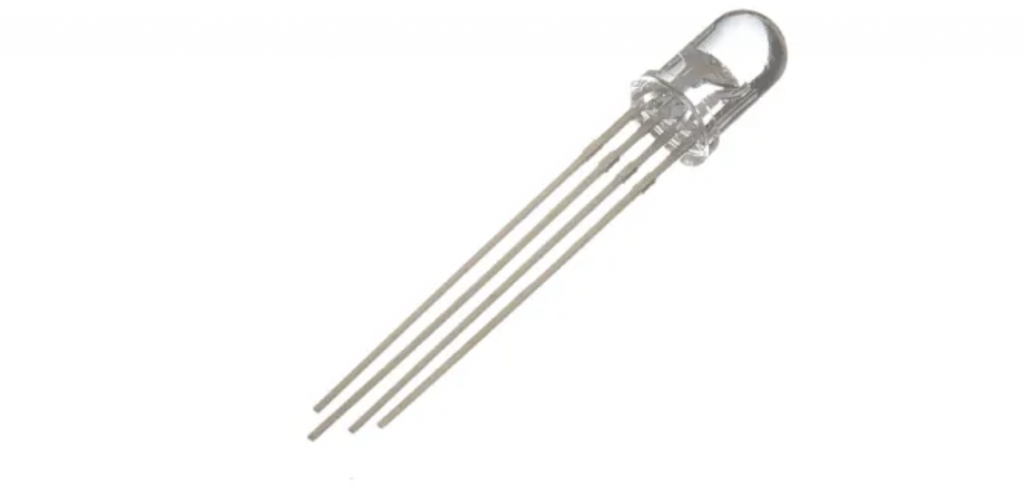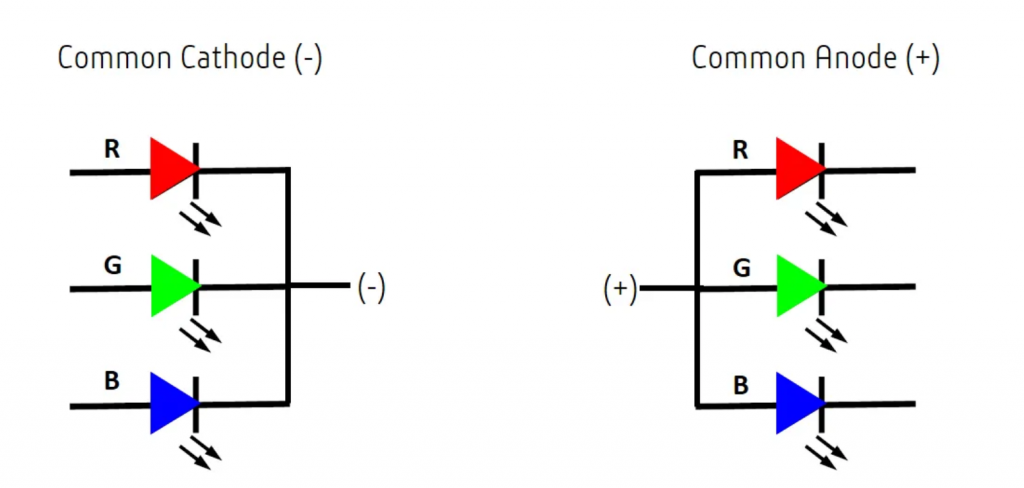An RGB LED is a combination of 3 LEDs in just one package:
1x Red LED
1x Green LED
1x Blue LED
You can produce almost any color by combining those three colors.
How to mix colors?
White light can be produced by mixing different coloured lights together, the most common method is to use the primary colours red, green and blue (RGB). As this mechanism involves the blending and diffusion of different colours, this approach is little used for the production of white lighting due to the tendency of it to have a slight tint or hue. Nevertheless, this method is particularly interesting for effect applications because of the flexibility of mixing different colours.
In principle, most perceivable colours can be produced by mixing different amounts of three primary colours, and this makes it possible to produce precise dynamic colour control as well. Utilising the DMX control protocol, it is actually possible to achieve a colour palate of over 16 million shades!
How does this work? Well, on each colour scale it is possible to select 256 levels or shades of that colour. If you have three primary colours and each one can have 256 different shades, then by mixing them together you can mathematically generate 16.7 million different colours. 255 x 255 x 255 = 16,581,375.
What does RGB LED work?
An RGB LED is basically an LED package that can produce almost any color. It can be used in different applications such as outdoor decoration lighting, stage lighting designs, home decoration lighting, LED matrix display, and more.
RGB LEDs have three internal LEDs (Red, Green, and Blue) that can be combined to produce almost any color output. In order to produce different kinds of colors, we need to set the intensity of each internal LED and combine the three color outputs.
By configuring the intensity of each LED, you can produce other colors as well.
For example, to produce purely blue light, you’d set the blue LED to the highest intensity and the green and red LEDs to the lowest intensity. For a white light, you’d set all three LEDs to the highest intensity.
RGB LED controllers work on a much simpler principal. They alter the power on each of the three channels (red, green and blue) to create a specific colour mix. To generate a purple colour, for example, the red and blue channels would be wound up, and the green channel turned off completely. Mixing blue and red light will give you the purple you are looking for. It is not as precise as DMX, but more than adequate for most residential and commercial applications where cost is a factor.
Common Anode and Common Cathode RGB LEDs
As mentioned earlier, RGB LEDs have three LEDs inside them and usually, these three internal LEDs share either a common anode or a common cathode especially in a through-hole package. So basically, we can categorize RGB LEDs as either common anode or common cathode type just like in seven segment displays.
When you look at an RGB LED, you’ll see that it has four leads. If you face it so that its longest lead is second from the left, the leads should be in the following order: red, anode or cathode, green, and blue.
There are two kinds of RGB LEDs: common anode LED and common cathode LED. The figure below illustrates a common anode and a common cathode LED.
In a common cathode RGB LED, all three LEDs share a negative connection (cathode). In a common anode RGB LED, the three LEDs share a positive connection (anode).
This results in an LED that has 4 pins, one for each LED, and one common cathode or one common anode.
RGB LED Pins
RGB LEDs have four leads—one for each LED and another for the common anode or cathode. You can identify each lead by its length, as shown in the following figure.
With the LED facing you so the anode or cathode (the longest lead) is second from the left, the leads should be in the following order: red, anode or cathode, green, and blue.
Summary
So RGB LEDs are really simple! They’re just three LEDs that share a common anode or a common cathode and to set their color, you just need to adjust the intensity of each LEDs inside them. I hope this article can help you understand what RGB is. Nowadays RGB LED lights are widely used and we are also committed to providing you with high-quality GRB floodlights. If you have any needs, please contact us.





